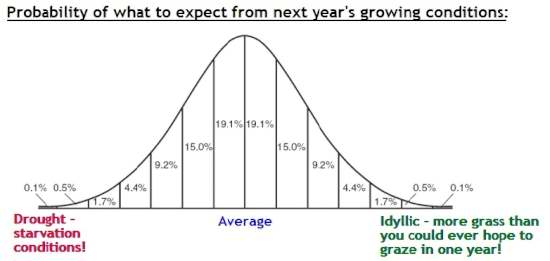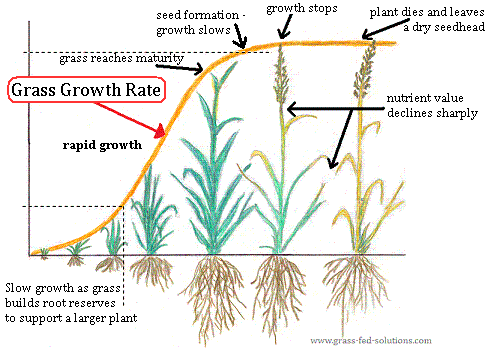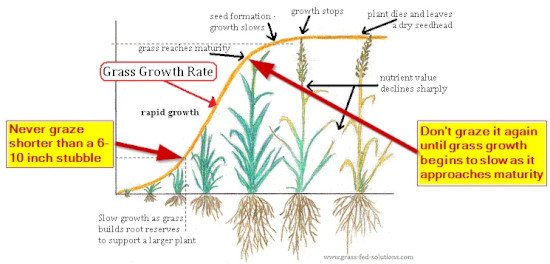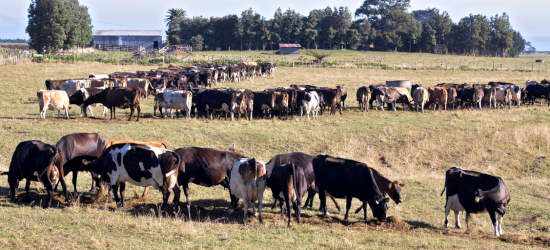1 2
Picture Credit score: Shever
With the exceptionally dry rising circumstances that many farmers skilled this summer time, I’ve devoted this text to reviewing the highest 10 drought administration methods for cattle farms. Half of those methods are for the dry years to reduce the toll that drought takes in your pastures and half are methods to implement throughout good years to arrange your pastures and your farm enterprise to be extra drought resistant sooner or later.
Common rising circumstances are literally fairly uncommon!
When the climate hits extremes the information media sometimes has a area day feeding us infinite tales of shock and awe concerning the unexpectedness and magnitude of the swing away from the 12 months’s “regular” rainfall and temperature. However as cattle farmers who depend on the land (and the climate) to supply feed for our cattle, we have to put aside this wide-eyed marvel at excessive climate. Climate extremes are regular. Plan for it. Cease anticipating common climate!
Common climate is outlined by its extremes. Our expectation of common climate is “created” by including up all of the climate extremes that swing both facet of the center.
A very common 12 months is definitely fairly uncommon – lower than as soon as each 5 to 10 years, on common… Against this, a “regular” 12 months contains not solely the mathematical common but in addition all of the years on both facet of common, together with the years when climate reaches extremes.
Tree rings can let you know concerning the vary of climate patterns which can be regular in your space
Have you ever ever taken the time to check tree rings from among the actually actually previous bushes in your space? You may be shocked at what you may be taught concerning the vary of rising circumstances you have to plan for in your grazing administration technique.
It is one factor to theoretically understand how a lot your native local weather can differ from 12 months to 12 months; it is fairly one other factor to truly see that variation play out in tree development rings from 12 months to 12 months over the course of centuries.
You be questioning what tree development rings should do with the grass in your pastures. Effectively, rising circumstances which can be good for bushes are usually additionally going to be good for grass. The identical is true for poor rising circumstances. However, whereas grasses are annual and due to this fact do not protect a bodily file of prior years’ development circumstances, bushes do. Tree rings are due to this fact a incredible proxy for the broad vary of rising circumstances you have to plan for in your grazing administration technique.
Picture Credit score: Jason Hollinger
I lately had the chance to see some freshly minimize stumps from a number of extraordinarily previous pines near the place I stay, every greater than 150 years previous. One factor that stood out was a repeating sample of roughly 30 years of large development rings adopted by 30 years of slender development rings, which corresponds remarkably nicely with historic data in our valley displaying a repeating sample of roughly 30 years of sizzling dry summers and chilly winters adopted by 30 years of cooler wetter summers and milder winters. These tree rings would recommend that our native local weather is now a couple of years into the following 30-year cycle of hotter, drier summers and colder winters.
However what additionally stood out for me was simply how a lot variation there was from 12 months to 12 months inside every of those longer cycles. Some tree rings displaying nearly no development in any respect, which should have been some really excessive years to expertise. Others displaying excessive development surges nicely exterior the norm – a digital farmer’s paradise.
Nor was any excessive 12 months routinely adopted by a return in direction of the typical – typically entire clusters of maximum years trace at droughts lasting a few years or, on the opposite excessive, idyllic rising circumstances lasting so a few years that had we been there to expertise these years by the lens of our personal restricted human notion of time it could have given us the misunderstanding that these idyllic development circumstances have been the brand new regular, solely to have them wiped away once more because the local weather pendulum lastly, inevitably, swung away once more in one other path.
In different phrases, the “regular” 12 months is a fable as a result of there is no such thing as a such factor as a single “regular” 12 months. In actuality a standard 12 months is solely any one of many doable climate circumstances from drought to common to idyllic alongside a sliding scale, as represented within the chart beneath.
 This chart reveals all of the rising circumstances which can be “regular” in your space. The chance curve reveals how typically every occurred over many centuries, very like including up tree rings of various widths.
This chart reveals all of the rising circumstances which can be “regular” in your space. The chance curve reveals how typically every occurred over many centuries, very like including up tree rings of various widths.
The bell curve of the graph represents the frequency (and thus the chance) of experiencing any one in every of these circumstances in any single 12 months. The wilder the swings in climate in your space, the flatter and extra stretched out this chance graph might be.
Though possibilities favor that subsequent 12 months’s climate might be nearer to “common” (perhaps solely a bit of bit drier or perhaps solely a bit of bit wetter), realistically it could fall ANYWHERE alongside this scale. Given a big sufficient variety of years, you WILL expertise all the prospects sooner or later in time. So, since wherever alongside the size is feasible in any given 12 months (even when some have a better chance of hanging than others), we actually ought to select to be ready as a substitute of shocked when one of many extremes does strike.
So, let us take a look at the Prime 10 Drought Administration Ideas for grazing throughout drought years…
The highest 10 drought administration methods listed beneath are cut up into two elements.
The primary 5 suggestions are for the dry years that will help you maximize pasture development and reduce soil evaporation throughout a drought, and that will help you defend the grass species in your pastures so that they recuperate quicker when the drought lastly ends.
The second 5 suggestions are for the great years that will help you put together your pastures to be extra drought resistant sooner or later.
Ideas 1 to five (drought survival)
1. Divide your pastures into DAILY GRAZING SLICES with the assistance of transportable electrical fences.
Swap to utilizing each day grazing slices to maximise pasture restoration intervals between grazing intervals. For instance of how this works, think about it takes 90 days to do a full loop round your grazing rotation. If that loop is split into 9 pastures (10 days per paddock), then your grass (and soil) has 80 days of undisturbed development and 10 days of grazing and trampling and churning by cattle ft. Then again, for those who use each day grazing slices, your grass will get 89 days of restoration between grazes – a complete 9 further days of undisturbed development!
There’s an previous saying that “a cow’s ft devour twice what her mouth does.”
Every day pasture slices can even reduce the quantity of grass that’s wasted to trampling and churning by cattle ft. The very first thing cattle do once they get right into a contemporary grazing slice is eat. By the point they’re able to wander about and discover the paddock or mattress right down to sleep or chew their cud, the majority of the grass has already been eaten and will not be wasted to cattle site visitors. Then again, when utilizing bigger multi-day pasture slices an enormous quantity of helpful grass might be wasted by trampling as a result of cattle do not simply freeze and stand nonetheless as soon as their bellies are full.
While you swap to utilizing each day grazing slices your cattle’s habits throughout grazing can even change. The small each day pasture slices will pressure cattle to bunch extra tightly collectively throughout grazing and, since all the great grass might be all passed by the tip of the grazing day, it creates intense competitors inside the herd. This causes the cattle to start grazing as a mob because the cattle enter right into a fierce competitors with each other for the very best grass. Every day grazing slices eradicate the posh of grazing as a bunch of choosy selective people.
This transformation in cattle habits creates a way more constant grazing affect in your pastures so that every one grass species are grazed equally fairly than the very best plant species being grazed proper to the bottom earlier than the much less tasty grass species are touched. Thus, each day grazing slices are an essential technique for shielding your greatest plant species in opposition to overgrazing throughout a drought.
Every day grazing slices additionally be certain that your cattle’s feed high quality stays constant from each day throughout the drought as a result of they get high quality contemporary pasture every single day as a substitute of top-grazing the very best grasses on the primary day after a pasture transfer after which going through deteriorating vitamin every single day till the pasture lastly runs out and they’re moved once more.
You’ll be able to be taught essentially the most environment friendly strategy to mix transportable and everlasting electrical fences for a each day grazing rotation within the article sequence concerning the smart electric fence grid. And within the core grazing rules article sequence you may find out about much more advantages of utilizing each day pasture strikes.
2. Go away a tall 6 to 10 inch stubble after grazing.
As I discussed within the earlier tip, switching to utilizing each day pasture slices will trigger cattle habits to vary (they start grazing as a mob). This in flip signifies that the stubble left behind when your cattle transfer on to the following pasture slice might be far more uniform in top than when utilizing bigger much less frequent pasture strikes. And, by merely various the dimensions of every day’s grazing slice, you might have an enormous quantity of management over how tall that stubble might be.
A tall stubble is your lifeline throughout a drought.
A tall grass stubble ensures that there’s a tall buffer of remaining plant materials to shade the soil and cut back air motion (wind) throughout the soil floor, each of that are very important to cut back moisture losses within the soil and thus cut back the severity of the drought in your pastures.
That stubble and the shade it gives additionally helps to maintain the soil floor from turning into a sun-baked hard-pan in order that the soil can rapidly take in even small quantities of rainfall as a substitute of dropping that rainfall to evaporation or runoff. When it does rain a bit of bit, the tall stubble offers the soil some shade to gradual floor evaporation to provide the rain extra time to soak in earlier than it evaporates. The stubble additionally serves as an impediment for puddling water to provide rainfall extra time to soak in earlier than it runs away down-slope.
Each drop of rain counts throughout a drought – a tall grass stubble is your main protection system to take full benefit of even very minimal rainfall so it isn’t misplaced to evaporation and runoff earlier than it has time to soak in and really do some good.
And in case you have been questioning, forsaking a tall grass stubble will not be a waste of grass. The grass left behind after grazing may have deeper root reserves, which signifies that your pasture grasses will have the ability to entry moisture deeper within the soil than for those who had grazed the grass shorter. Moreover, root quantity tends to reflect above-ground plant quantity as a result of roots die again after grass is grazed. Grass that’s grazed actually brief will initially develop fairly slowly till it will get to be about 6-10 inches tall; that is the peak at which the basis reserves regain a vital mass to help quicker plant development, as illustrated within the picture beneath.
 Grass development charges differ drastically relying on plant maturity.
Grass development charges differ drastically relying on plant maturity.
Leaving a tall grass stubble signifies that grass would not should undergo that slower development part whereas it rebuilds its root reserves – a tall stubble ensures that it could stick with it rising as quick as doable, thus serving to maximize grass productiveness over the entire season and lowering the time it takes earlier than you may re-graze the pasture once more. This idea is defined intimately within the first article within the core grazing rules article sequence.
3. Mix your herds into as few teams as doable.
Combining your herds into as few teams as doable has a variety of advantages. The bigger the herd, the extra of a mob-grazing impact it creates, which suggests you get extra environment friendly use of your pastures (extra even grazing strain to the plant species within the pasture combine and a extra constant stubble). A bigger herd additionally reduces your administration prices (much less electrical fences and fewer herds to maneuver every single day). And combining your herds additionally makes it a lot simpler to funds your grass reserves and calculate forward to ensure that your grazing herd is shifting gradual sufficient to provide the grass time to recuperate totally between grazing passes.
4. Feed some hay to let your pastures catch up.
This tip is designed to provide your pastures a break so you may maximize grass development charges.
As pasture yields start to deteriorate throughout a drought, the grazing rotation will start to catch as much as itself, both forcing farmers to graze every pasture tougher (shorter than the best 6-10″ stubble) or to graze it sooner earlier than the grass development reaches maturity.
If farmers go for grazing every pasture tougher by leaving a shorter stubble, that not solely slows grass development, but in addition compounds the drought drawback by exposing the soil to larger charges of soil moisture evaporation.
Then again, if farmers select to re-graze their pastures sooner earlier than the grasses have reached maturity, then that additionally will cut back pasture yields since you’re not benefiting from the total time interval when grass development charges are maximized.
This is one other have a look at the picture from the second tip – discover how grass development charges do not drop off till the plant reaches maturity. Maximizing pasture productiveness is about timing grazing in order that your herd returns simply because the pasture reaches maturity after which solely grazes it sufficiently to go away behind a tall 6-10″ stubble so speedy development can proceed instantly after grazing.
 Maximize pasture yields by grazing as quickly as grass reaches maturity (not earlier than, not after), and at all times depart behind a tall grass stubble so most development charges can resume instantly.
Maximize pasture yields by grazing as quickly as grass reaches maturity (not earlier than, not after), and at all times depart behind a tall grass stubble so most development charges can resume instantly.
As soon as the grazing rotation begins to catch as much as itself the unprepared farmer has to select between two dangerous decisions – graze sooner, or graze every slice tougher. Both alternative units off a vicious cycle of additional drops in pasture yields and will increase soil moisture evaporation and plant degradation.
The ready farmer, alternatively, will faucet into his hay reserves (hopefully he has a drought reserve, mentioned in tip #6 beneath) to feed some hay to his cattle for a couple of weeks to provide the pastures a bit of further time to continue to grow earlier than resuming the grazing rotation.
A number of weeks of hay fed early in a drought season pays enormous dividends by rising pasture yields and defending soils from extra extreme drought. It could even be the dividing line between whether or not it’s a must to begin promoting cattle to make it by the drought.
 Feeding hay on pasture to provide the grazing rotation time to catch up.
Feeding hay on pasture to provide the grazing rotation time to catch up.Picture Credit score: Dave Young
5. De-stock early.
In some unspecified time in the future it should change into clear that your pastures will not suffice and it’s possible you’ll must unload some cattle to make it by the drought.
Begin promoting early.
A ten% discount in your herd measurement early in a drought could nicely tip the pasture yields again to sustainable ranges and prevent having to unload 25% or extra of the herd at a later date.
However the pure response is to attend and hope whereas the hungry mouths of your cattle herd proceed plowing by your diminishing grass reserves and the grass stubble will get so brief that the drought has a way more extreme and long-lasting affect in your pastures. Then, when the scenario reaches a vital stage, you may be left promoting cattle when costs are particularly low as a result of all of your neighbors can even be flooding the markets with their cattle. And your brood cattle could also be left so skinny that even when they survive, their conception charges could also be disastrous within the subsequent breeding cycle (see this text about body condition scores for extra details about how letting cattle get too skinny can have dramatic penalties to conception charges even many months after your cattle have regained their misplaced fats reserves).
For those who suspect a possible grass scarcity, de-stock early whereas costs are nonetheless excessive and when trimming a couple of poorer high quality animals out of your herd could also be all it takes to remain forward of decrease pasture yields. A small herd measurement discount early on can normally be achieved by promoting a couple of lighter meat animals and by culling your least productive animals (cows that you’ve got flagged as having a historical past of calving difficulties, well being points, poor feed conversion, or poor high quality calves). Ready till later means you may should chunk far deeper into your prime brood animals and promote animals which can be the long-term bread and butter of your enterprise.
Trending Merchandise

ZuPreem FruitBlend Bird Pellets, Daily Bird F...

ZuPreem Sensible Seed Bird Food, Parakeet, Bu...

Kaytee Forti-Diet Egg-Cite Parakeet Pet Bird ...

Best Nest Wellness Mama Bird Probiotics ̵...

Kaytee Fiesta Macaw Food, Nutritious and Fun ...

Pet Eye Cream Health for Dogs, Cats, Cattle, ...






